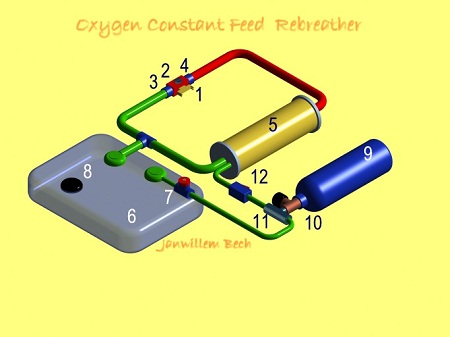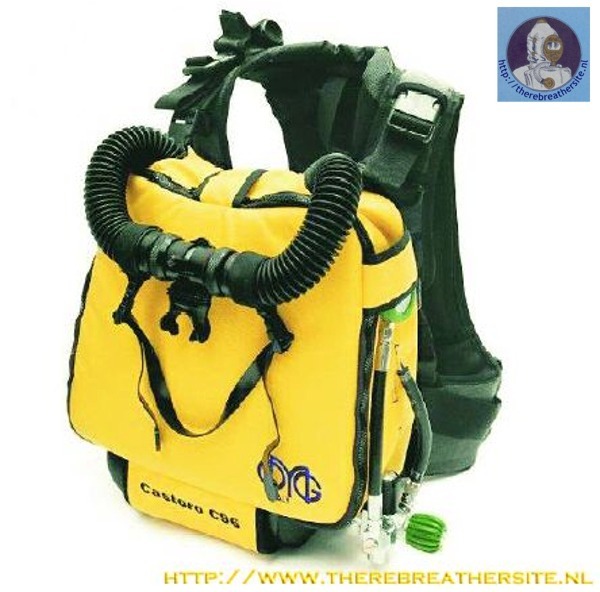
The oxygen rebreather (OR) is the most simple rebreather there is. The OR also is the most used rebreather in the diving market. This is because this unit is in use with many army’s in the world.
The reason why the OR is the most used rebreather is because it can be dived for clandestine operations. The OR is a type of diving gear that does not produce bubbles and is the type used by the military all over the world. If you want to dive an oxygen rebreather you need to do a specialized course. The principle of the unit seems very basic, and in fact also is, but there are some dangerous aspects that need to be trained an known.
The oxygen rebreather consists of a breathing loop usually with flapper valves that force the breathing gas in one direction. Also there is a scrubber that absorbs the carbon dioxide. The gas supply consist of a dosage system and oxygen cylinder. Finally the unit is completed with a counterlung. The counterlung is needed for the gas storage when the diver exhales the gas. Now when the diver swims he will use oxygen. Typically the oxygen consumption is :
| Action | Oxygen Usage l/min | Breathing volume l/min |
|---|---|---|
| Rest | 0,3 | 7 |
| low swimming | 0,7 | 18 |
| Medium swimming | 1,2 | 30 |
| Heavy swimming | 1,6 | 40 |
| Very heavy swimming | 2,4 | 60 |
| Extreme working | >4,0 | >120 |
The oxygen inhaled by the diver is metabolized and approximately 90% of the oxygen is exhaled as carbon dioxide. This gas is forced through the valves in the direction of the scrubber. In the scrubber the carbon dioxide is chemically absorbed by the absorbent and the oxygen-poor gas follows its route to the counterlung. From the counterlung the diver inhales the next cycle and so on. When a certain amount of gas has been used by the diver he feels the need for additional gas. Depending on the system this gas is added manually or by mechanical means. It is of great importance when the diver starts diving the nitrogen content from the system is purged. This is because normal air contains 79% nitrogen. When the oxygen is used the diver still has enough volume to breath and he does not feel the need for adding oxygen. He will breath an oxygen poor mix and loses his consciousness. Therefore is is of extreme importance the system is flushed with pure oxygen several times before he starts diving.

Het niet flushen is voor menig ongetrainde duiker reden geweest bewusteloos te raken. Dit gebeurt ook op het land als de duiker een volgelaatsmasker opzet en niet flushed. Wat er gebeurt is zoals hierboven beschreven hij dus de zuurstof in de contralong opmaakt maar nog wel kan ademen omdat er voldoende gas is. Dit gas zal echter hypoxisch zijn (zuurstofarm) en beneden de ca 10% zal de duiker afhankelijk van zijn conditie en leeftijd tussen 1 en 3 minuten bewusteloos raken. Onderwater leidt dit vaak tot verdrinking. Het is daarom essentieel dit principe goed te begrijpen en altijd meerdere malen te flushen.

This website provides a very comprehensive set of descriptions of oxygen systems.
These can be found in the oxygen rebreathers database.
In particular, the gas delivery system determines the type of oxygen rebreather. A common system injects oxygen constantly, often just below the diver’s consumption. He will then occasionally have to add some oxygen manually via the bypass button. In the past, most systems were exclusively manually operated. Nowadays, oxygen is often added pressure-controlled. Once the contralung takes on a smaller volume, a regulator will kick in and add oxygen.
Below we show the principle diagram of a CMF oxygen rebreather as an explanation of how it works;

- Mouthpiece
- Diver Surface valve (DSV)
- Upstream valve
- Downstream valve
- Scrubber
- Counterlung
- Dossage (CMF) unit
- Overpessure valve
- Oxygen cylinder
- Cylinder valve
- Pressure reducer
- Manual bypass
Through a dosage unit a constant MASS of oxygen is added to the rebreather. The quantity of oxygen is normaly just a little below the metabolic use of the diver. Usually 0,9 ltr/min. The diver breathes through the inlet valve (see # 3) the rich oxygenmix. After breathing out the gas leaves through valve (see # 4) in the direction of a scrubber (see # 5). The scrubber removes the carbondioxide. Now new oxygen is added in the next cycle.
Warning!
Never use the oxygen rebreather for diving deeper then 6 meters
always flush the rebreather minimum 3 times
ALways dive in buddy pairs
Follow the course for your specific model rebreather
many divers before you where killed because they did not follow these rules!


Therebreathersite was founded by Jan Willem Bech in 1999. After a diving career of many years, he decided to start technical diving in 1999. He immediately noticed that at that time there was almost no website that contained the history of closed breathing systems. The start for the website led to a huge collection that offered about 1,300 pages of information until 2019. In 2019, a fresh start was made with the website now freely available online for everyone. Therebreathersite is a source of information for divers, researchers, technicians and students. I hope you enjoy browsing the content!
